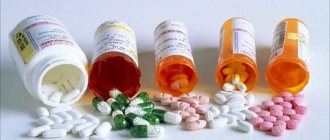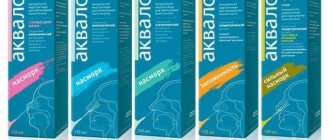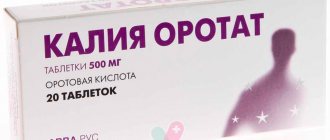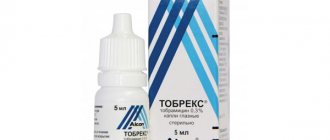Release form and composition
Dosage form - tablets: oblong, almost white or white in color, on one side - engraving “51N” (40 mg tablets) or “52N” (80 mg tablets), on the other - the company symbol (7 pieces in a blister, in a cardboard box there are 2 or 4 blisters with 40 mg tablets or 2, 4 or 8 blisters with 80 mg tablets and instructions for use of Micardis).
Active ingredient: telmisartan, its content in 1 tablet is 40 or 80 mg.
Excipients: sodium hydroxide, polyvidone (kollidon 25), sorbitol, meglumine, magnesium stearate.
Price
The cost of modern medicines for the treatment of arterial hypertension is quite high.
A noticeable effect occurs after 4 weeks, sometimes later.
Before starting the course, the patient must check the cost of the package so as not to interrupt the course if financial difficulties arise.
Using the composition for less than the specified period does not give a positive effect.
The cost depends on the number of tablets in the package:
| Dosage | Amount in a package | Average price in Russia | Average cost in Ukraine |
| 40 mg | 14 | 520 rub. | — |
| 80 mg | 7 | — | 190 UAH |
| 80 mg | 28 | 950 rub. | 770 UAH |
| 80 mg (Plus) | 7 | — | 210 UAH |
| 80 mg (Plus) | 28 | 950 rub. | 850 UAH |
Pharmacological properties
Pharmacodynamics
The active ingredient of Micardis, telmisartan, is a specific angiotensin II receptor antagonist. It is characterized by high affinity for the AT1 receptor subtype of angiotensin II, through which the action of angiotensin II is carried out. Telmisartan does not have an agonistic effect on angiotensin II and displaces it from its connection with the receptor, and forms a connection only with the AT1 receptor subtype of angiotensin II, and the binding is long-lasting.
The drug has no affinity for other angiotensin receptors, including the AT2 subtype. Their functional significance and the effect of possible stimulation by angiotensin II, the concentration of which increases with the use of telmisartan, have not been studied.
Telmisartan reduces the concentration of aldosterone in the blood. Does not block ion channels and does not inhibit renin in blood plasma. Does not inhibit kininase II (angiotensin-converting enzyme) and an enzyme that also has the ability to destroy bradykinin, so an increase in side effects caused by bradykinin is not expected.
When taken at a dose of 80 mg, telmisartan completely blocks the hypertensive effect of angiotensin II. The effect of the drug is observed within 3 hours after the first dose, persists for 24 hours and remains significant for up to 48 hours. A pronounced antihypertensive effect develops after 4–8 weeks of constant use of Micardis.
In patients with arterial hypertension, Micardis reduces diastolic and systolic blood pressure without affecting heart rate.
After abrupt withdrawal of telmisartan, blood pressure levels gradually return to the original level, which is not accompanied by the development of withdrawal syndrome.
Pharmacokinetics
Telmisartan is rapidly absorbed from the gastrointestinal tract after taking Micardis orally. Its bioavailability is 50%. In the case of simultaneous food intake, the AUC value (area under the concentration-time curve) decreases: the figure ranges from 6% (with a dose of telmisartan 40 mg) to 19% (with a dose of 160 mg). 3 hours after taking Mikardis, the plasma concentration of the drug levels out, regardless of the time when food was taken.
Telmisartan is characterized by high binding to plasma proteins (mainly albumin and alpha1-glycoprotein) - more than 99.5%. The apparent volume of distribution at equilibrium is on average 500 l.
The drug is metabolized by conjugation with glucuronic acid, resulting in the formation of pharmacologically inactive metabolites. It is excreted primarily through the intestines unchanged, less than 2% of the dose is excreted by the kidneys.
The half-life is more than 20 hours. Total plasma clearance is 900 ml/min, hepatic blood flow is 1500 ml/min.
Pharmacokinetics in special clinical situations:
- gender: in women, the maximum concentration and AUC are higher than in men, approximately 3 and 2 times, respectively, while no significant differences in the effectiveness of Micardis were noted;
- elderly age: pharmacokinetic parameters in elderly patients do not differ from those in young patients, so dose adjustment is not required;
- children's age from 6 to 18 years: when using Micardis at a dose of 1 mg/kg or 2 mg/kg for 4 weeks, the pharmacokinetics of telmisartan are approximately similar to those in adults, which confirms the nonlinearity of the pharmacokinetics of the substance, especially in relation to the maximum concentration;
- renal failure and hemodialysis: the characteristics of telmisartan do not change, so dose adjustment is not required. Hemodialysis does not help remove the drug from the body;
- mild to moderate liver dysfunction (classes A and B on the Child-Pugh scale): the daily dose of telmisartan should not exceed 40 mg.
Reviews of Mikardis 80
Micardis 80 mg is an effective means for regulating blood pressure. Patients note a stable effect within 24 hours. Doctors recommend taking the tablets in a course and under the supervision of medical personnel.
Doctors
Igor Lvovich, cardiologist, Moscow.
The product normalizes blood pressure and prevents its increase. It has a mild diuretic effect and promotes the removal of sodium from the body. The effect occurs within 2-3 hours after taking the tablet. The drug reduces mortality and prevents the development of complications due to diseases of the cardiovascular system. I prescribe with caution in case of renal failure.
Egor Sudzilovsky, therapist, Tyumen.
The drug is prescribed for hypertension. The active component displaces angiotensin, but does not affect bradykinin. It causes less side effects than other antihypertensive drugs. After administration, blood vessels dilate and blood pressure decreases, but the heart rate remains unchanged. The course of treatment should be at least a month. The dosage is selected individually and, if necessary, gradually increased.
While taking the drug, it is better to refuse to control complex mechanisms.
Contraindications
Absolute:
- Hereditary fructose intolerance (due to sorbitol content);
- Severe liver dysfunction (class C according to the Child-Pugh scale);
- Obstructive diseases of the biliary tract;
- Primary aldosteronism;
- Age up to 18 years;
- Pregnancy and lactation period;
- Hypersensitivity to the components of Micardis tablets.
Relative:
- Hyperkalemia;
- Hyponatremia;
- Coronary heart disease (CHD);
- Chronic heart failure;
- Idiopathic hypertrophic subaortic stenosis;
- Stenosis of the aortic and mitral valve;
- Decreased circulating blood volume due to diarrhea or vomiting, limited salt intake and/or previous diuretic therapy;
- Impaired liver and/or kidney function;
- Bilateral renal artery stenosis or stenosis of the artery of a single kidney;
- Conditions after kidney transplantation.
Mikardis, instructions for use: method and dosage
Micardis tablets should be taken orally. Eating does not affect the effectiveness of the drug.
For arterial hypertension, treatment is recommended to begin with a daily dose of 40 mg in 1 dose. If the therapeutic effect is insufficient, the daily dose is increased to 80 mg in 1 dose, it should be taken into account that the maximum hypotensive effect of Micardis develops within 4-8 weeks after the start of therapy.
To reduce the risk of cardiovascular disease, it is recommended to take 80 mg once a day. At the beginning of treatment, additional correction of blood pressure may be required.
The daily dose of Micardis for patients with mild to moderate liver dysfunction (Child-Pugh classes A and B) should not exceed 40 mg.
How to take Micardis 80?
The product must be taken orally with a small amount of water. It is better to take it during or after meals.
For adults
The recommended dosage for adults, according to the instructions for use, is 40 mg (half a tablet) 1 time per day. Some patients may be prescribed 20 mg (a quarter tablet) once a day. The maximum dosage is 2 tablets per day. In the presence of severe arterial hypertension, hydrochlorothiazide may be additionally prescribed in the amount of 12.5-25 mg/day. Within 1-2 months of regular use, a decrease in blood pressure to normal levels is observed.
For children
In childhood, taking the drug should not be started.
Can Micardis 80 mg be divided in half?
If necessary, divide the tablet in half or into 4 parts.
Taking the drug for diabetes mellitus
The product can be taken for diabetes. To prevent the development of hypoglycemia, the doctor must adjust the dosage.
The product can be taken for diabetes.
Side effects
- Infections: upper respiratory tract infections, urinary tract infections (including cystitis), sepsis (including fatal);
- Hematopoietic system: decreased hemoglobin concentration, eosinophilia, anemia, thrombocytopenia;
- Respiratory system: shortness of breath;
- Central nervous system: depression, anxiety, fainting, insomnia, vertigo;
- Cardiovascular system: marked decrease in blood pressure, bradycardia, orthostatic hypotension, tachycardia;
- Digestive system: increased liver enzymes, gastric discomfort, dyspepsia, dry mouth, diarrhea, flatulence, abdominal pain, vomiting, and liver dysfunction or liver disease (in post-marketing surveillance, these disorders were identified in patients from Japan) ;
- Urinary system: increased concentrations of uric acid and creatinine in the blood, impaired renal function (including acute renal failure);
- Musculoskeletal system: cramps of the calf muscles, pain in the back, tendons and lower extremities, myalgia, arthralgia;
- Organ of vision: visual disorders;
- Skin and subcutaneous tissues: hyperhidrosis;
- Allergic reactions: rash (including drug rash), skin itching, eczema, toxic rash, hypersensitivity (urticaria, erythema, angioedema), anaphylactic reactions, angioedema (including fatal);
- Other: asthenia, flu-like syndrome, chest pain;
- Laboratory indicators: increased blood creatine phosphokinase levels, hyperkalemia; hypoglycemia in patients with diabetes mellitus.
Side effects of Micardis
The overall incidence of adverse events with telmisartan (41.4%) is generally comparable to placebo (43.9%) in placebo-controlled studies. The incidence of side effects does not depend on the dose and gender, age or race of patients. The adverse reactions listed below were identified in clinical trials involving 5,788 patients taking telmisartan. Infections and infestations : urinary tract infections (including cystitis), upper respiratory tract infections. Mental disorders: anxiety. On the part of the organ of vision: impaired accommodation (blurred vision). Vestibular disorders: dizziness. Gastrointestinal: abdominal pain, diarrhea, dry mouth, dyspepsia, flatulence, impaired stomach function. From the skin or subcutaneous tissue: eczema, increased sweating. Musculoskeletal and connective tissue disorders: arthralgia, back pain, calf cramps or leg pain, myalgia, tendinitis-like symptoms. General disorders: chest pain, flu-like symptoms. In addition, cases of erythema, pruritus, syncope/loss of consciousness, insomnia, depression, vomiting, hypotension (including orthostatic hypotension), bradycardia, tachycardia, hepatic dysfunction, renal dysfunction, including acute renal failure have been reported from post-marketing surveillance (see PRECAUTIONS). USE), hyperkalemia, dyspnea, anemia, eosinophilia, thrombocytopenia, weakness and lack of effectiveness. The incidence of these effects is not known. As with other angiotensin II antagonists, isolated cases of angioedema, urticaria and other similar reactions have been reported. Laboratory tests: rarely noted a decrease in hemoglobin levels or an increase in uric acid levels; also reported cases of increases in creatinine or liver enzymes, but the incidence was similar or lower compared with placebo. In addition, according to the results of post-marketing surveillance, cases of increased serum CPK levels were reported.
special instructions
In some patients, due to suppression of the renin-angiotensin system (RAAS), especially with the simultaneous use of several drugs that affect this system, renal function is impaired, up to acute renal failure. For this reason, therapy accompanied by dual blockade of the RAAS (for example, a combination of Micardis with an angiotensin-converting enzyme inhibitor or a direct renin inhibitor) should be carried out individually and under careful monitoring of renal function, including monitoring of serum creatinine and potassium concentrations.
If vascular tone and renal function depend primarily on the activity of the RAAS (for example, in chronic heart failure or kidney disease, including stenosis of the renal artery(s), the use of drugs affecting this system can lead to the development of acute arterial hypotension, oliguria, hyperazotemia and even acute renal failure.
In case of simultaneous use of Micardis with potassium-containing supplements, potassium-sparing diuretics, potassium-containing table salt or any other drugs that increase the concentration of potassium in the blood, this indicator should be monitored during treatment.
In patients with diabetes mellitus with associated additional cardiovascular risks (eg, coronary artery disease), the likelihood of fatal myocardial infarction and sudden cardiovascular death increases. At the same time, coronary artery disease in patients with diabetes mellitus may be asymptomatic and undiagnosed. For this reason, for the timely detection and treatment of coronary artery disease, before prescribing Micardis to patients with diabetes mellitus, it is necessary to conduct appropriate diagnostic studies, including an exercise test.
Micardis is less effective in black patients.
Impact on the ability to drive vehicles and complex mechanisms
Special clinical studies have not been conducted on the effect of Micardis on the ability to concentrate and speed of reactions. However, given the likelihood of developing side effects such as drowsiness and dizziness, it is recommended to be careful when driving vehicles and working with potentially dangerous mechanisms.
Reviews
Doctors and patients positively evaluate the antihypertensive properties of the drug Micardis. Regular use brings blood pressure back to normal; if you stop taking the pills for various indications, there is no “withdrawal syndrome.” For effective treatment and reducing the risk of side effects, you need to follow the dosage, take timely tests to monitor blood counts, and avoid the simultaneous use of telmisartan-based tablets and certain medications.
Use during pregnancy and lactation
Studies of the effect of telmisartan on human fertility have not been conducted.
In the first trimester of pregnancy, angiotensin II receptor antagonists are prohibited. If pregnancy is diagnosed during treatment, Micardis should be immediately discontinued and, if necessary, alternative therapy should be prescribed (antihypertensive drugs of other groups approved for use during pregnancy).
In the second and third trimesters of pregnancy, the use of Micardis is not recommended. Although teratogenic effects have not been identified in preclinical studies, fetotoxicity (decreased renal function, delayed ossification of the skull, oligohydramnios) and neonatal toxicity (arterial hypotension, hyperkalemia, renal failure) have been established.
Therefore, Micardis is contraindicated during pregnancy. If for some reason the drug was used in the second trimester, an ultrasound examination of the bones and kidneys of the fetus is recommended. Newborns whose mothers received telmisartan should be closely monitored for the development of hypotension.
Women planning pregnancy should be initially prescribed alternative therapy.
During lactation, the use of Micardis is contraindicated.
Overdose
Exceeding the recommended dosage in the instructions leads to arterial hypotension. With a pronounced decrease in pressure, dizziness, weakness, sweating, and a feeling of cold in the arms and legs occur. It is necessary to stop taking the drug and consult a doctor.
Dizziness is one of the signs of a drug overdose.
Drug interactions
- Other antihypertensive drugs: their effect is enhanced;
- Digoxin: its concentration in the blood plasma increases;
- Ramipril: its maximum and total (during the entire observation time) concentration increases by 2.5 times, but the clinical significance of this interaction has not been established;
- Lithium preparations: there is a reversible increase in their concentration in the blood, accompanied by a toxic effect;
- Non-steroidal anti-inflammatory drugs (NSAIDs), incl. acetylsalicylic acid, non-selective NSAIDs and type 2 cyclooxygenase inhibitors: the risk of developing acute renal failure in patients with dehydration increases (before prescribing this combination, it is necessary to conduct a study of renal function and compensate for the volume of circulating blood). It is also possible that the antihypertensive effect of telmisartan may be reduced.
Interaction with other drugs
Before using the product, it is necessary to study the interaction with other medications. The active component of this drug helps to increase the concentration of lithium in the blood and Digoxin.
Combination not recommended
ACE inhibitors, potassium-sparing diuretics, and dietary supplements containing potassium may increase blood potassium levels when taken together.
Carefully
With the simultaneous use of telmisartan and Ramipril, the concentration of the latter in the blood plasma increases.
During administration, the hypotensive effect of hydrochlorothiazide and other drugs to lower blood pressure increases. Caution must be exercised when prescribing with lithium preparations.









